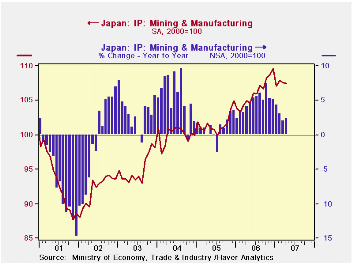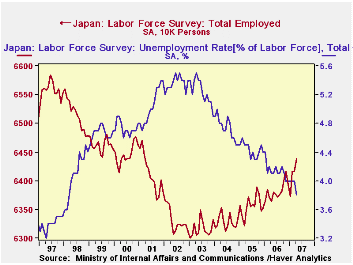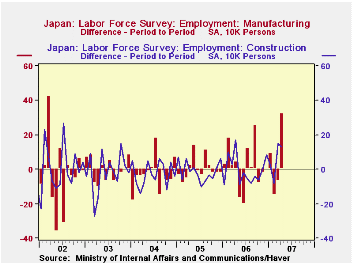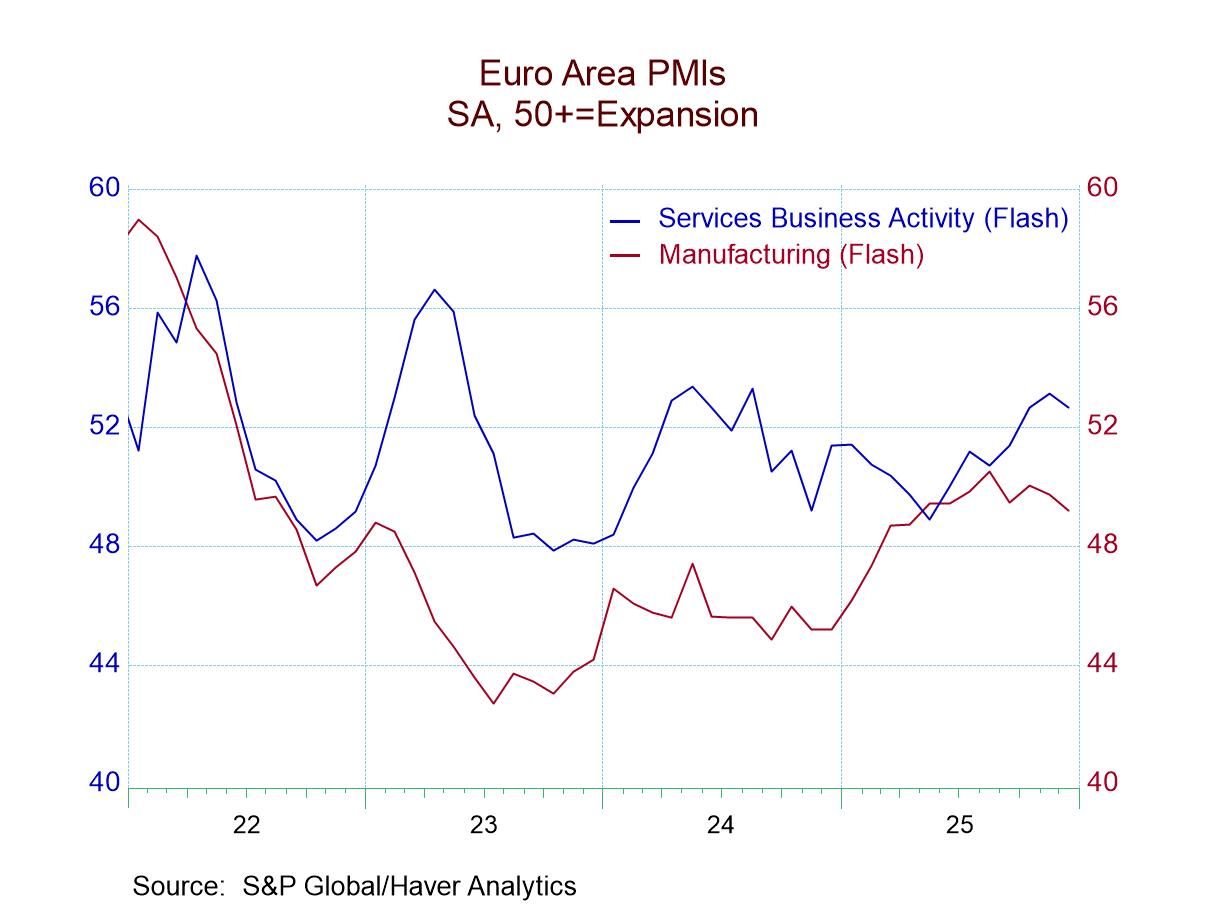 Global| May 30 2007
Global| May 30 2007Japan's Labor Market Looks Its Best in Several Years, but Industry May Have Lost Steam
Summary
Which data are telling the better story in Japan? Production or the labor market? Today's industrial production report continues the theme of "relapse" that Bob Brusca was talking about here on May 15. Total industrial production fell [...]

Which data are telling the better story in Japan? Production or the labor market?
Today's industrial production report continues the theme of "relapse" that Bob Brusca was talking about here on May 15. Total industrial production fell 0.1% in April, a small decline to be sure, but the second in a row. Production in two key sources of prior strength, "producer goods" and the vehicle industry, contributed to the decline, the latter also for a second month. The peak in total output was actually back in December, at 109.6, just over 2 points above the April amount.
In sharp contrast, the labor market looks good: employment has risen and unemployment declined. According to the April labor force survey, which was published May 29 in Japan, the number of people employed increased 23,000 in the month, a third consecutive rise, reaching 64,390,000, the highest since March 2001. In the Haver database "G10+", we include seasonally adjusted data for a number of industry sectors. Manufacturing contributed 220,000 to the latest monthly increase. Construction also gained, and miscellaneous services rebounded from a sudden drop in March. The numbers employed in trade and finance decreased, however.
Construction also gained, and miscellaneous services rebounded from a sudden drop in March. The numbers employed in trade and finance decreased, however.
The unemployment rate went down in April to 3.8% from 4.0%, where it had been since November. The number unemployed fell to 2,560,000 in April from 2,690,000 in March. Importantly, this decline accompanied a small increase in labor force participation. As seen in the last graph, the participation rate edged up to 60.66% from 60.57% in March. This is the highest ratio of labor force or economically active to the population over age 15 since the summer of 2003. Sometimes, as we remind frequently here, the unemployment rate falls because discouraged workers back away from the labor force. But in this case, more Japanese people are actually working or are seeking work. This pattern suggests some confidence in the economy. Indeed, it goes along with an entirely separate gauge, the "Living Anxiety" survey, which fell 5 points from February to April. Measured bi-monthly, this private research index goes down when people feel less bad. That strikes us as an appropriate approach presently, when there are many questions about the economies of Japan and its neighbors: less emphasis on ebullience and more on being cautious. Employment goes up as production goes down: which force will prevail?
This pattern suggests some confidence in the economy. Indeed, it goes along with an entirely separate gauge, the "Living Anxiety" survey, which fell 5 points from February to April. Measured bi-monthly, this private research index goes down when people feel less bad. That strikes us as an appropriate approach presently, when there are many questions about the economies of Japan and its neighbors: less emphasis on ebullience and more on being cautious. Employment goes up as production goes down: which force will prevail?
| JAPAN | Apr 2007* | Mar 2007* | Feb 2007* | Year Ago* | 2006 | 2005 | 2004 |
|---|---|---|---|---|---|---|---|
| Industrial Production (2000=100) | 107.5 | 107.6 | 107.9 | 104.9 | 106.2 | 101.3 | 100.2 |
| Producer Goods | 115.9 | 116.3 | 115.2 | 111.2 | 113.3 | 106.2 | 104.9 |
| Transport Goods** | 127.9 | 130.9 | 132.7 | 125.8 | 127.6 | 118.2 | 113.5 |
| Employment (10,000 people) | 64.39 | 64.16 | 64.15 | 63.64 | 63.82 | 63.56 | 63.29 |
| Manufacturing | 11.84 | 11.52 | 11.59 | 11.74 | 11.61 | 11.42 | 11.50 |
| Unemployment Rate (%) | 3.8 | 4.0 | 4.0 | 4.1 | 4.1 | 4.4 | 4.7 |
| Participation Rate (%) | 60.7 | 60.6 | 60.6 | 60.3 | 60.1 | 60.4 | 60.4 |
Carol Stone, CBE
AuthorMore in Author Profile »Carol Stone, CBE came to Haver Analytics in 2003 following more than 35 years as a financial market economist at major Wall Street financial institutions, most especially Merrill Lynch and Nomura Securities. She had broad experience in analysis and forecasting of flow-of-funds accounts, the federal budget and Federal Reserve operations. At Nomura Securities, among other duties, she developed various indicator forecasting tools and edited a daily global publication produced in London and New York for readers in Tokyo. At Haver Analytics, Carol was a member of the Research Department, aiding database managers with research and documentation efforts, as well as posting commentary on select economic reports. In addition, she conducted Ways-of-the-World, a blog on economic issues for an Episcopal-Church-affiliated website, The Geranium Farm. During her career, Carol served as an officer of the Money Marketeers and the Downtown Economists Club. She had a PhD from NYU's Stern School of Business. She lived in Brooklyn, New York, and had a weekend home on Long Island.





